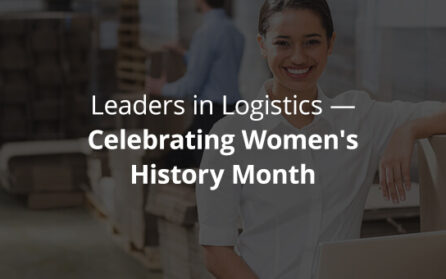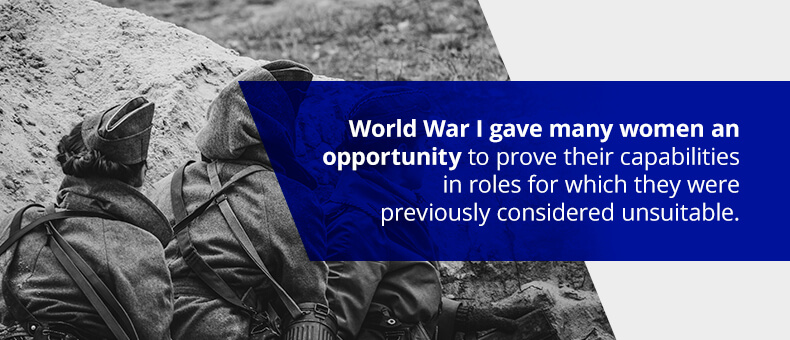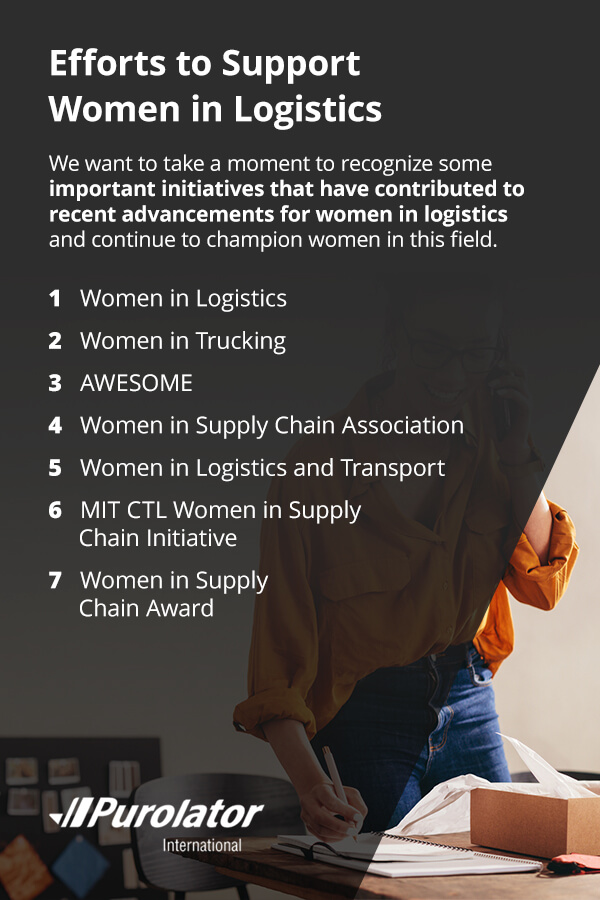Blog
Leaders in Logistics — Celebrating Women’s History Month

March is Women’s History Month, and there’s no better time than now to put a spotlight on women in the logistics industry, which is traditionally associated with men. Though women continue to be a minority in this field, they’ve made their mark on the industry throughout history and are gaining greater representation within logistics today. From truck drivers to supply chain management executives, women succeed in a variety of roles across the supply chain and help propel the industry forward.
Let’s take a moment to learn about the history of women in logistics, the current state of women in logistics, efforts to support women in this field and what the future of women in logistics might look like.
The History of Women in Logistics
One of the earliest female leaders in logistics was Sarah Clark-Kidder who, in 1901, was voted as president of her husband’s railroad after his death. Clark-Kidder wasn’t just the first female president of a railroad — she also managed to take the railroad from being in serious debt to becoming more profitable than ever. Female business leaders were quite rare at this time in history.
In the early 20th century, just 20% of women worked outside the home. The percentage was much lower for married women, at just 5%. For women who did work, they were mostly relegated to certain career fields or lower-ranking roles.
In logistics, along with other career fields, women began to gain some footing during World War I, when they were welcomed into male-dominated fields out of necessity. As men left to fight overseas, women increasingly took on industrial jobs, including warehouse work. World War I gave many women an opportunity to prove their capabilities in roles for which they were previously considered unsuitable.
Toward the end of World War I, the first female truckers entered the industry. Trucking was a new enterprise, and women like Luella Bates and Lillie Drennan made their mark on the profession early on.
Lillie Drennan even started a trucking company along with her husband. After getting divorced, she became the sole owner of the company in 1929. She also received her commercial truck driver’s license this year from the Railroad Commission, making her the first licensed female truck driver. The examiners were hesitant to give Drennan her license due to a hearing impairment, but Drennan suspected the real issue was one of gender bias and famously declared, “If any man can beat my record, I’ll just get out of here.”
World War II once again gave women a boost in the labor market. However, it wasn’t until the latter quarter of the 20th century that women really began to gain greater representation in the workforce, including in logistics. By the early 1990s, 74% of women between ages 25 and 54 were participating in the labor force. However, there continued to be gender disparities in certain professions, including logistics, that still persist to some degree today.
The Current State of Women in Logistics
Despite advancements in logistics and gender equity, many women in logistics still feel powerfully outnumbered at work or at trade shows, networking events and educational sessions. In 2016, research and advisory company Gartner Inc. partnered with Achieving Women’s Excellence in Supply Chain Operations, Management and Education (AWESOME) to begin conducting a Women in Supply Chain Survey. This survey has been published annually ever since.
In both 2019 and 2020, the total percentage of women in the supply-chain workforce was 39%. That’s an impressive percentage compared to decades past, but it means women are still in the minority. The gender disparity is far more exaggerated when looking at women in supply chain management roles.
In 2020, 17% of chief supply-chain officers were women, which was the highest percentage yet and a marked improvement from the previous year’s 11%. Still, this percentage means that more than four out of every five chief supply-chain officers are men. The percentage of women in supply-chain vice president or senior director roles is a bit better, though this percentage declined from 28% in 2019 to 21% in 2020.
When it comes to pay equity, logistics outperforms some other fields. In 2016, the Bureau of Labor Statistics (BLS) compared 120 occupations to see how men and women were paid for the same jobs. Of the eight occupations that showed very little disparity in pay, half of them were related to logistics. This included order fillers, shipping, receiving and traffic clerks.
Though increasing numbers of female professionals have entered the logistics field over the years, there are still marked gender disparities — especially in leadership roles. Why is this?
The answer likely comes down to multiple factors, including implicit gender bias within companies and preconceptions about what sorts of career paths women should pursue. A female student with an aptitude for supply chain management may not even consider studying that subject in college since she perceives it as a traditionally male career path. Changing the tide to be more gender-inclusive in logistics will take time, but it’s a goal worth pursuing.
Though men and women do not all fit neatly into common ideas of gender stereotypes, most people believe women naturally offer different skill sets than their male counterparts — skill sets that can be advantageous in the professional world and in logistics. One study found that 74% of men and 96% of women believe that women’s skill sets are advantageous for supply chain management. These skills include multitasking, collaboration, communication and influence.
Efforts to Support Women in Logistics
Fortunately, individuals and organizations are actively pursuing the goal of inviting more women into the field of logistics and supporting these women to help them achieve their professional goals. We want to take a moment to recognize some important initiatives that have contributed to recent advancements for women in logistics and continue to champion women in this field.
1. Women in Logistics
In 1981, Stacy Roth founded Women in Transportation. Her goal was to help women in Northern California working in logistics and related fields, making this organization one of the earliest resources for women in the industry. Today, the organization — now called Women in Logistics (WIL) — includes both male and female members and continues to help logistics professionals learn and network to advance in their careers. Members span the fields of logistics, transportation, technology, freight forwarding and supply chain management.
The organization especially prides itself on its mentor program. In addition to this program, WIL hosts quarterly events and an annual golf tournament, awards an annual scholarship, maintains a job bank and allows members to post their resume in a resume vault where it may be discovered by potential employers.
2. Women in Trucking
In 2007, Ellen Voie founded the Women in Trucking (WIT) Foundation. Voie, who still serves as the organization’s president and CEO, is an industry leader and a speaker and author on the topic of gender and inclusion in non-traditional work settings, such as trucking. In 2012, the White House recognized Voie as a Transportation Innovator Champion of Change.
The Women in Trucking Foundation is a nonprofit organization designed to encourage more women to become truckers, to help them succeed in the field and to celebrate their professional successes. One way WIT celebrates women is by giving out an annual award. The foundation also hosts events and provides resources to help women in this traditionally male-dominated industry.
3. AWESOME
In 2012, Ann Drake became the first woman to receive the Distinguished Service Award from the Council of Supply Chain Management Professionals (CSCMP). Drake wondered why women before her hadn’t achieved this honor. The following year, she founded Achieving Women’s Excellence in Supply Chain Operations, Management and Education (AWESOME) to help other women learn how to overcome obstacles in supply chain management and eliminate these obstacles entirely. Since Drake’s achievement, two other women have received the Distinguished Service Award.
AWESOME is based out of Chicago and has helped empower women across the U.S. to enter and rise through the ranks in the supply chain industry. The organization achieves this goal in several ways, but one of the prominent ways is through scholarships. In 2021, AWESOME plans to expand its Excellence in Education Scholarship Program, offering 20 scholarships annually to women studying supply chain management at the university level.
4. Women in Supply Chain Association
In Calgary, Alberta in 2012, the Women in Supply Chain (WISC) Association was born. The WISC initiative was created within the Van Horne Institute. Peter Wallis, the president at the time, helped lead the initiative alongside Linda Lucas, the then chairperson of the Calgary Logistics Council.
WISC Association helps women in logistics across Canada in a number of ways. They offer networking and education experiences, promote career opportunities, sponsor research and facilitate conversations to advance the supply chain industry and help individual women advance in their own careers.
5. Women in Logistics and Transport
Not all the organizations uplifting women in logistics are in the Western Hemisphere. Women in Logistics and Transport (WiLAT) was founded in 2013 under the Chartered Institute of Logistics and Transport. WiLAT seeks to promote the logistics industry to female members across the globe, advocate for women in the industry and help these women succeed. The organization focuses on four key areas — leadership, mentorship, entrepreneurship and empowerment.
Today, WiLAT has grown to encompass thousands of members across Northwest and Southeast Africa, the Indian Ocean Islands, Australasia, Asia, Europe and the Middle East. Each of these regions has local chapters where female logistics professionals can network. WiLAT also hosts a global conference annually.
6. MIT CTL Women in Supply Chain Initiative
The Massachusetts Institute of Technology Center for Transportation and Logistics (MIT CTL) has led the way for more than four decades in supply chain management research and education. Recognizing the gender gap in logistics and the benefit that greater female representation can bring for the industry, MIT CTL created the Women in Supply Chain Initiative (WISCI).
The initiative is aimed at better understanding the problem of gender imbalance in the supply chain and providing knowledge and tools that companies can use to help them promote better gender balance within their organizations. WISCI hosts events such as roundtable discussions and leadership panels to share these insights and bring the supply chain community together.
7. Women in Supply Chain Award
Supply and Demand Chain Executive (SDCE) is an industry organization that publishes a leading magazine and hosts events for supply chain executives. They also recognize industry leaders through awards, one being the Women in Supply Chain Award. This award celebrates female supply chain leaders and executives who are making an impact through their accomplishments and role modeling. SDCE especially seeks to honor women who are helping other women at every level of a company’s supply chain network.
SDCE first recognized women with this award in 2020. That year, they received more than 300 nominations and recognized 136 of these women. The award recipients spanned every sector of the supply chain. Offering awards can be an excellent way of honoring leaders and inspiring women at various stages of their careers to achieve greatness within the logistics industry.
The Future of Women in Logistics
Women’s History Month isn’t just a time to reflect on women’s history — it’s a meaningful opportunity to consider women’s futures. For the logistics industry, it’s a time to consider how women can continue to advance in this field and how logistics companies can benefit from greater gender equality. There’s no doubt that women have come a long way in logistics, but there’s still a long way to go.
Women remained dramatically outnumbered by men in this field. Thankfully, the organizations above and the efforts of individual companies are helping usher in progress. If the current trends continue, we’ll see more women enter the field, thrive in their roles and ascend into upper management positions. The industry is sure to benefit from greater diversity and representation at all levels of the supply chain.
Within Purolator, we’re making gender representation a focal point for our future success. In 2019, we hosted a panel discussion focused on how we can take steps in this direction. The panel featured women in our organization whose unique insights were helpful to the organization as a whole. Purolator’s National Diversity and Inclusion Council spearheads ongoing efforts to continually make Purolator a more inclusive, diverse workforce.
Partner With Purolator International for Simplified Shipping to Canada
If you’re a U.S.-based business that needs a logistics partner to help you ship to, from and within Canada, Purolator International offers the flexible and simple solutions you need. We can handle everything from small packages and parcels to freight. Our logistical planning services can help you optimize your supply chain, as well. We understand best practices for efficient supply chain management, including when that supply chain spans national borders. To learn more about Purolator International and how we can help meet your logistics needs, contact us today.



